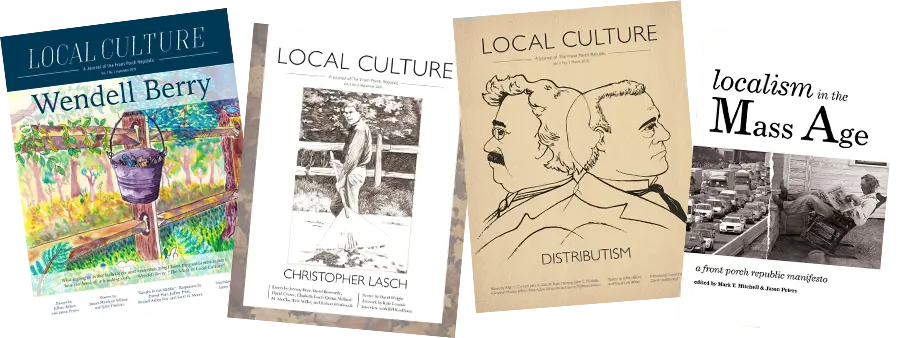“Only connect!” is the tagline of E.M. Forster’s classic Howards End. It is suggested as the key lesson for life. Whether or not “only connect” is the law we ought to live by, connection is significant. It is also seemingly more challenging than ever.
America seems to be having a connection crisis. It is hard to find research or opinion-based writing suggesting that our isolation and loneliness epidemic is in any way improving. Apparently, Americans are becoming homebodies in the midst of a friendship recession. Mark Zuckerberg believes AI friends are good, and will sell, because most Americans want more friends than they have.
There are many potential causes for our current situation. Most likely, all the suspects bear some guilt. As far back as Civilization and Its Discontents, Freud pointed out that while people celebrate the telephone for connecting friends and family who now live far apart, it is technology that has made that moving apart seem possible and palatable. Technology probably deserves some of the blame for our isolation, but it shares it with our long commutes, COVID, transience, cultural norms, polarization, and declining church attendance, among other things.
“What is to be done?” The question echoes from Chernyshevsky to Tolstoy to Lenin and it is always a good one. No doubt there are great programs and policies to be implemented. But what are some simple practices we can adopt in our daily lives, in the meantime? Anything we have not already discussed at length? What are some ways we can be better connected and encouraged right now? I have three ideas for you.
Waffles
Coming to us all the way from Australia is a trend called “Wednesday Waffles.” In Australia, a “waffle” can be more than a food; it can be a kind of casual conversation. In this trend, friends film a short video of themselves with a casual update on their week and they send it to the friend group. It typically happens on Wednesdays.
Wednesday Waffles has been promoted as a way to help people stay connected, especially young men. According to some psychologists, Wednesday Waffles can save friendships. If you hop over to TikTok, you can find dozens of videos of young men explaining how they realized they were drifting away from their friends and never really checking in with anyone. Waffles helped turn that around. In case you were wondering, men are more affected by shrinking social circles than women.
I was inspired to try it myself with some of my friends. Our waffles are “weekly” (they typically happen on Sundays) instead of “Wednesday” and involve 1-3 minute videos. It’s everything the promoters say it is. The videos are casual and frequent enough that you can get some insight into the daily lives of friends who live far away. The labor is light enough that even your friends who are overwhelmed can participate. Plenty of people with small children can’t easily make dinner plans to catch up. Plenty of busy people struggle to line up a good time for a phone call. But pretty much anyone can record a 1-3 minute video and send it. Time zones don’t matter. Background noise is welcomed.
Weekly waffles are really fun. I look forward to getting the Sunday updates. I think the waffles also work well because they’re weekly. Humans need a sense of security in connection. Knowing that you can expect a video most weeks gives you a sense of security and builds continuity in your friendships. It also plays into our need for routines and rituals.
It’s true that the waffles are not conversations, but that is a strength. They are a supplement, not a substitute. Waffles are like short letters, maybe a postcard. That makes them better than the occasional text, which can be a conversation one second and then abruptly stop being anything. Waffles have clearer expectations and better definition. Waffles are a nice form of regular correspondence.
The Margarita Mile
In spring of 2024, I ran a 5K with a friend. At that race, other local races were being advertised. One was a “Margarita Mile.” You’d sign up, run a mile, and then you’d get a margarita at the finish line. My friend and I realized that we could put on something like that ourselves.
In 2024, I held my first Margarita Mile. I’ve done more since then. It’s simple. I invite a group of friends. Using sidewalk chalk, I mark a start line and some arrows on the sidewalk in front of my house. It’s an out and back course, so I mark the turn, too. People are invited to show up, run or walk a mile, and then I provide margaritas. My guests bring snacks. My line is “drinks on me, snacks on you.” People are encouraged to bring friends and feel free to come and go. No one has to drink and no one really even has to walk or run. People show up who do neither.
It’s been really fun. As of August 1, 2025, I have now hosted four of these. It’s a really casual way to gather people. It involves some healthy activity, but everyone goes at their own pace. Some people run and watch their time. Some people jog. Some people walk. Some people cheer from the sideline. Lots of people bring chips and salsa, but sometimes we get Costco pizza or something exciting like Pão de Queijo. One time I made margarita-flavored frosted sugar cookies.
This is a really easy event to host. It’s pretty simple to use sidewalk chalk to mark the course and it makes people feel special to see the course marked. I provide the margarita ingredients, but people mix their own, to taste. You get to enjoy the great outdoors. There are nearly unlimited modifications available. You could have a Mojito Mile, or a Martini Mile. You could have a Sprite Sprint or a Rum Run. I would love to participate in a Whoopie Pie Walk. It doesn’t have to be running or walking. You could have a Pepsi push-up or pull-up event or a Capri-Sun Challenge of some kind. It could be Poems and Pickles—you recite a poem and get a pickle. What about Chess and Chips?
It’s fun to have a signature event. My goal is to host one every quarter. For the last one, I took a big step and put up a cork board in my living room, which I have decorated with pictures from past events, and people can put comments or PRs on the board. People like semi-regular events. Trying to host a semi-regular event also helps you build in patterns of hospitality. Like other good practices, hospitality has to be practiced. We get better at it as we do it.
I also think that hospitality is one of the best ways to play offense in the isolation epidemic. People feel more welcomed into your life when you welcome them into your home. It’s not the same as meeting up somewhere. Probably because it is more meaningful, hospitality in our homes is also hard. It’s more work to get your home ready for people (even if you don’t do that much) than it is to meet somewhere. If people bail at the last minute, it hurts more. It’s easy to become judgmental when people aren’t reciprocal. (And so many people are not reciprocal and just cancel so easily. See Dixie Dillon Lane’s “The Other Cancel Culture.”) Hospitality is more demanding than other forms of socializing, but it is also high reward.
The Catherine Project
This spring, I participated in my first book discussion group with the Catherine Project. We spent several weeks reading Madame Bovary and meeting on Zoom Tuesday nights to discuss it. I knew none of the other participants prior to logging on. But I enjoyed meeting and discussing with people who were like-minded in their love of reading and desire for intellectual connection. It was a really good experience.
The Catherine Project is a non-profit that offers courses and reading groups for adults of all kinds. There is no tuition and no required educational background. Most things take place on Zoom and people join from many countries. Since they started in 2020, they’ve served over 4,000 readers and offered over 600 courses. They read the classics: “We read books of richness, depth, and lasting value that bear repeated re-readings. A great book teaches readers at every level, from beginners to scholars.” This fall you can join reading groups for things like Heidegger’s Being and Time, Dostoevsky’s The Brothers Karamazov, or Aristotle’s Nicomachean Ethics. They also have tutorials for Latin and ancient Greek. They even have a “core program” that “offers a way into the study of great books and introduces readers to our approach to learning through discussion.”
After high school or college, many people express an interest in reading and discussing the big things in life. But outside of a classroom, it’s not always that easy to find those conversations. Some people need the group accountability to hit their reading goals. Many people start book clubs with their friends, but it’s easy for those to fall apart. You don’t need to have a serious academic background to participate in a Catherine Project reading group, but the act of filling out the form to sign up seems to make people take their participation more seriously. Sometimes disappointing strangers is harder than disappointing people you know. And because your group is probably filled with people you don’t already know, you’re more likely to hear some perspectives you’d otherwise not encounter.
The life of the mind is like other forms of life—it needs to be nourished, and it requires community. Designating time for close reading and good conversation is a practice that can enrich your life. If, like me, you get paid to read books and teach them, it’s also important to sometimes be another participant rather than the leader. It’s good for your voice to weigh no more than anyone else’s. And it’s good to be part of a community of readers that is entirely voluntary with no transactional element.
These are a few options for increasing personal connection that I have experienced in the past year. They may not be new to you. But they are newer to me and, however novel they are or aren’t, I’ve really enjoyed them. All of them require something of you, which is part of what makes connection possible. And connection is very possible.
Loneliness and isolation are perhaps at all-time highs in the West. Lots of people are experiencing it, many people are talking about it, and some people are studying it. Much of the response has focused on who and what is to blame and the relationship between loneliness and long-term trends. The overall picture is discouraging, but we can still act and encourage each other in the short-term. I think it makes sense to try to connect and to share what we find that works.
Image via Freerange.






